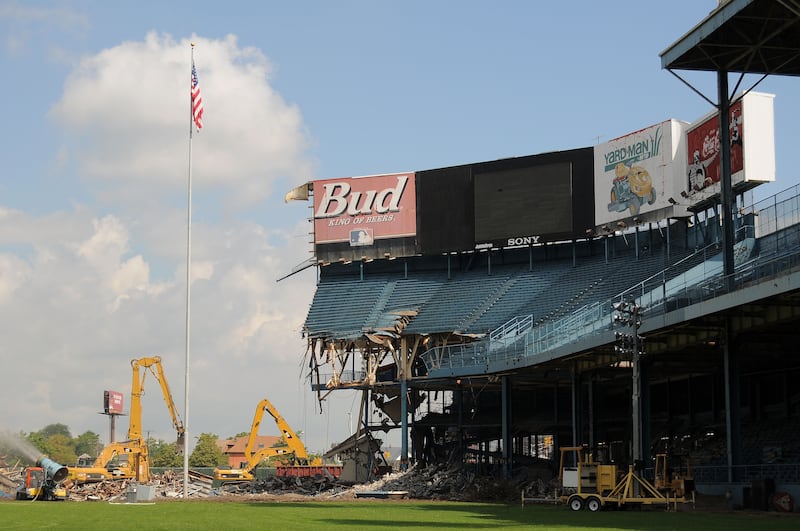Detroit prides itself on being tougher than the rest so it is going to take a brave soul to inform them that Motor City is just an extension of Cork city, with more soul food and less hurling.
If you walk up Michigan Avenue from downtown, you arrive after about 15 minutes on a low-slung, red-paved section of the city with signs proclaiming it to be Detroit’s “oldest existing neighbourhood”, and that the original settlers were Irish. Lest the world be in any doubt as to what part of Ireland the new arrivals came from in the 1850s, they named it Corktown.
The neighbourhood has changed immensely over the past 170 years but the Corkie name has stuck. And suddenly Detroit’s energy – the subtle swagger and low-key self-assurance, the music and the sports obsessions, the you-are-here-and-nowhere-else attitude – began to make sense. On the main road from the airport, first-time visitors eventually shoot past a blue neon sign bearing the city’s name, a futuristic version of the famous Hollywood sign.
Given the decades of urban decay and the reputation Detroit has attained as the perennial bad boy of American cities, the sign was the subject of much mockery and mirth. Notions! But really, they should have added a neon hand with an index finger raised. See, Detroit doesn’t care what others think. It has had all the insults flung and the unwanted records – for crime and losing football seasons and demolished buildings – slung at it. Now, as the city and its people remain regally self-assured that there is nowhere quite like it. Sound familiar?
READ MORE
If you mention another city to Detroiters – Milwaukee or Chicago – they will smile indulgently and almost imperceptibly throw their eyes to heaven. You can’t walk into a restaurant or past a clothes shop without seeing a sign “Detroit Born”.Tell any Detroiter you’ve always wanted to visit their city and they will give you a look of puzzlement and you can almost hear a voice, Gurranabraher- or Glen-tinted saying, “course you did, boy”. If “Dowtcha, boy” is the imperishable Cork phrase, Detroit has “whatupdoe”.
Corktown was and remains central to Detroit. The city’s most grandiose and famous building, Michigan Grand Central, the towering symbol of the unstoppable growth and wealth which propelled the city through the first half of the century, is in Corktown. So too is the fabled Tiger Stadium, as essential to Detroit as Páirc Uí Chaoimh is to Cork city. Detroit being Detroit, Tiger Stadium doesn’t actually exist any more. But there has been a baseball park at the corner of Trumbull and Michigan Avenue for 104 years.
What started as Navin Field and Briggs Stadium became Tiger Stadium in 1912 and it was a beauty, lavish and white-painted and tiered: in aerial shots it almost looks like a ship. By 1975, it was placed on the National Register of Historic Places but that couldn’t save it. The team owners and city planners had, by the 1990s, become obsessed with the fashion for flashy, new stadiums and its final Major League Baseball game was played there in 1999. Despite a decade of campaigning by Detroiters to save the stadium, it was razed a decade later, only to be reborn, in 2015 as The Corner Ballpark, a baseball park where youngsters now learn the game on the very spot where the Tigers played.

The riots of 1967, sparked by the arrest of 87 people celebrating the homecoming of two Vietnam veterans, rolled across the city and on to the streets near Tiger Stadium. Today, there is very little evidence of Cork’s imprint on the section of Detroit that bears its name. But few families have had such a singular impact on any city as the Fords from Cork have had on Detroit: William emigrated from the county at the age of 20 and settled in Dearborn; his son Henry, a perpetual tinkerer, built himself a motor car and by 1908 had patented the Model-T.
[ Story of car assembly in Ireland takes a curiously personal turnOpens in new window ]
Within 10 years, half of all the cars driven in the United States were Model T Fords. And by then, Ford had opened a factory in Cork. The rise and fall and rise of Ford mirrored the fortunes of Detroit over the century. The home that Henry and Clara Ford built – a jaw-dropping limestone structure overlooking the Rouge river – 56 rooms, an indoor bowling alley, a swimming pool – was occupied by the family only from 1915 until 1950 – Ford died, aged 83, in 1947. For a time, it passed into the care of the University of Michigan but upkeep was crippling: the pile was restored by the Ford family in 2015 and although renovations are ongoing, people are free to roam around its exterior and vast gardens.
[ US election: The swing state battles that will decide the race to the White HouseOpens in new window ]
Ford’s is a complex legacy and he is remembered now for his virulent anti-Semitism as much as for his phenomenal business accomplishments.
But the name and series of cars the Ford company put out – the Thunderbird, the Mustang – have over the decades became part of the image of Detroit.
And it is tempting to believe that the nowhere-like-it certainty of the original Corktown-ers has helped to give the Motor City its unquenchable self-belief. They could officially twin Cork and Detroit.
But what would be the point?
If you know, you know.















